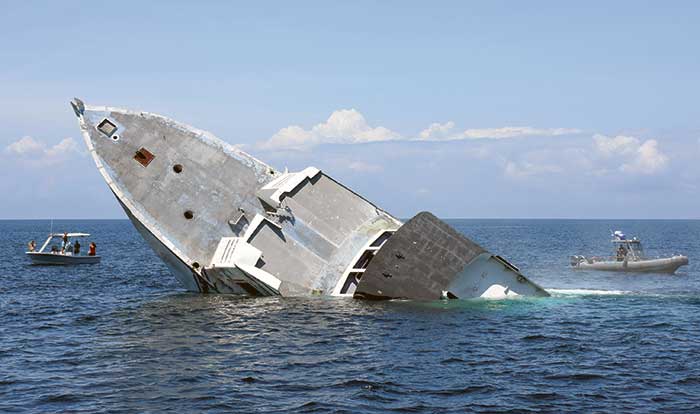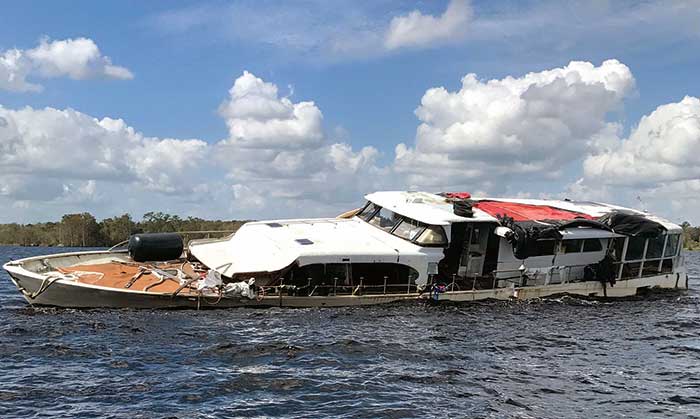Advertisement
Florida legislature and law enforcement seek to remove hundreds of derelict vessels from state waters and prevent vessels from becoming derelict in the first place.

A sailboat wrecked by Hurricane Irma in the Florida Keys. (Photo: FWC)
Just 10 days before Halloween 2017, a ghost ship washed up on South Walton Beach, Florida. Phantom of the Aqua, a 45-foot sailboat, ran aground after her owner abandoned ship while sailing to the U.S. Virgin Islands. She sat on the beach for six months and soon became a popular tourist attraction.
"There were three weddings on the beach next to Phantom, and art classes would go out and sketch it," said Gerald Nelson, owner of Southern Marine Services, the salvage company that removed the vessel. When the day finally came to pull the boat from the beach, hundreds of onlookers watched the action, and Phantom fans lined up in beach chairs to catch a final glimpse of their beloved boat.
Most derelict vessels are far less popular. In fact they're generally considered a blight on Florida's waterways. According to Major Robert Rowe, section leader over the Boating and Waterways Section at the Florida Fish and Wildlife Conservation Commission (FWC), there are roughly 450 to 500 derelict vessels on state waters at any given time. They're more than just an eyesore. Approximately 20% to 30% of these vessels are navigational hazards.
The problems don't stop there. "We tend to think of derelict vessels as waterway management issues, but they're also huge environmental and human safety issues," said Brandy Elliott, a senior attorney at FWC.

El Dorado, a 147-foot vessel was wrecked by Hurricane Michael in Panama City, Florida. The vessel cost $1.2 million to remove and was subsequently made into an artificial reef off the coast of Bay County Florida in the Gulf of Mexico. (Photo: FWC)
In the case of Phantom, there were immediate concerns about the environmental impact. "It had gray water, sewer, fuel, and batteries on board, so we called an environmental company to come remove the toxins," said Nelson. There was also a rush to remove it before spring break. "We were scared that kids would be climbing all over it to take selfies and fall and get hurt."
Boats like Phantom can wind up costing taxpayers a fair bit of money. According to Rowe, pulling a derelict vessel from the water in a nonhurricane response costs between $400 and $700 per foot. "That runs upward of $15,000 to $20,000 per boat," he said, and the cost only goes up from there. A single hurricane boat might cost $20,000 to $40,000. After Hurricane Irma, state and federal governments spent $52 million dealing with derelict vessels.
A Final Resting Place For Derelict Boats?
What happens to derelict boats once they've been removed from the water? Typically, they're added to landfills. But a new pilot project by Rhode Island Fiberglass Vessel Recycle (RIFVR) has developed a process that converts them into fuel for cement manufacturing.
"This is an issue that no one has solved yet," said Chris Edmonston, president of BoatUS's Foundation for Boating Safety and Clean Water. "RIFVR could show the nation a more environmentally friendly solution to boat disposal, and we look forward to the findings and hopefully expanding the program."
How Do Boats Become Derelict?
In Florida, storms and natural disasters produce staggering numbers of derelict boats. "When Hurricane Irma hit in 2017, it wrecked thousands of boats in the state," said Rowe. "We assessed more than 2,600 vessels statewide and removed 944 of those with our own funds. That doesn't include the 1,600 boats removed by their owners and insurance companies."
Economic factors also contribute to the problem. "We know that vessels have a finite life span and that they're going to deteriorate if there's no upkeep and maintenance. When people face hard economic times, either on an individual or community level, a vessel becomes difficult to maintain," said Elliott.
The life of a derelict starts off as the dream of living on the water.
"I tell everyone the life of a derelict starts off as the dream of living on the water," said Rowe. "People come down here and buy a boat that's economical for them, not realizing what they're getting into. They struggle to maintain the vessel, and eventually it just gets out of hand. Something happens — machinery failure, the boat sinks — and the cost becomes exponentially higher because they have to float the vessel and make even more repairs then they did before. At that point, some people don't know what to do, and just walk away."
Risky Business
"There are a lot of things we can do to improve that situation. The biggest thing is our at-risk legislation that came online in 2016," said Rowe. Florida's At-Risk Law was introduced with the goal of catching vessels before they become derelict. The law says that a vessel is "at risk" of becoming derelict if it has any one or more of five characteristics, which include taking on water, breaking loose from its anchor, or not having an effective means of propulsion. "It's a phase that boats go through before they become derelict where we have an opportunity to address them," said Rowe.
So what happens when a vessel is cited as an at-risk vessel? "There's a penalty for vessels at risk of becoming derelict," said Elliott. "It's a noncriminal infraction, but there are increasing fines over time. The first offense is $50, the second offense that occurs 30 days or more after the first is $100, and a third or subsequent offense that occurs 30 days or more after a previous offense is $250." Once a vessel becomes derelict, things become more serious.
Advertisement
"In Florida, a derelict vessel is a criminal violation, first-degree misdemeanor," said Elliott. She explained that owners could face both criminal and civil penalties in addition to remaining responsible for the cost of removal. "If you allow your vessel to become derelict, you're required to pay the removal costs." If the state recovers it, the owner is required to pay back those costs. "This might not sound like it has any bite, but we can place a hold on their vessel and vehicle registrations in Florida until they repay."
Enforcement Gets A Boost
In the past, FWC hasn't had a reliable source of funding to remove derelict vessels. After Hurricane Irma in 2017, it was given $1 million to make available to local cities, counties, and law enforcement in the form of grants for derelict boat removal and disposal. There was no clear indication that funding would be made available for future hurricanes.

A derelict vessel awaits removal. (Photo: FWC)
On July 1, 2019, a new law, signed by Florida Gov. Ron DeSantis, went into effect that added a source for ongoing grant funding for derelict boat removal. Going forward, a percentage of vessel registration fees is deposited into the Marine Resources Conservation Trust Fund, then distributed in the form of grants to local governments for derelict vessel removal.
The law also made way for a two-year FWC study to investigate the degree to which boats being stored long-term outside public mooring fields contribute to the number of derelict or abandoned vessels, as well as the impact of these vessels on local communities. "Basically, we want to know what impact those boats are having on derelict vessel response and on local economies of mooring fields," said Rowe.
Turning A New Leaf
Are derelict boats changing their ways? While it may be too early to know the full impact of Florida's new legislation, Rowe sees a net positive effect. "We're getting these folks to take care of their boats and address these issues before they become even bigger," he said. "There were 564 citations last year alone (and hundreds of citations issued in previous years) that could have become derelict boats had they been left to continue to deteriorate."
These innovative programs may well prove to be a model for other jurisdictions. "Florida's at-risk laws are a leading example of proactive measures to reduce the number of derelict vessels on state waters," said BoatUS Government Affairs manager David Kennedy. "BoatUS recognizes the significant environmental and waterway management challenges that derelict vessels present and appreciates the state supporting these initiatives."
Derelict Database
View a map listing derelict vessels in Florida by visiting FWC's website. The database includes information about navigation hazards so that you can plan your trip accordingly.
Recidivism
Of course these rules haven't put all boats on the straight and narrow; some have even gone on to become repeat offenders. Phantom of the Aqua ran aground a second time.
"Unfortunately, Hurricane Michael hit and she didn't survive," said Nelson. "I had to go down there and take her apart." Today, her remains sit in Nelson's backyard. But that's not to say Phantom won't rise again. "We kept a lot of the hardware, everything that made it unique, with the anticipation of maybe one day resurrecting and rebuilding it. There's still hope that Phantom will roar back to life again."
GEICO | BoatUS Marine Insurance Has You Covered
What's Covered?
Both salvage and wreck removal are included in all GEICO | BoatUS Marine Insurance policies. It makes no difference how a boat is damaged — hurricane, striking a submerged object, sinking at the dock, operator error — all are the same when it comes to salvage and wreck removal.
With salvage, your boat is recovered and brought to a repair facility, where insurance pays for the cost of repairs not exceeding the insured value.
With wreck removal, the cost of repairs exceeds the policy value and the boat is recovered, possibly in pieces, and disposed of according to local guidelines, generally at a landfill.
Who Organizes The Salvage?
Unlike some boat insurers, BoatUS arranges for the salvage or wreck removal. We find the right contractor with the right equipment, barges, transport, and permits, and ensure professional, safe, and timely service.
What About Environmental Cleanup Costs?
Fuel-spill liability protects you from claims for cleanup or third-party damage due to the accidental discharge of oil or fuel that can occur in a sinking, fire, collision, or grounding. All BoatUS policies provide coverage up to the maximum amount for which you can be held liable under federal law, which today is a whopping $939,800. BoatUS.com/Insurance
